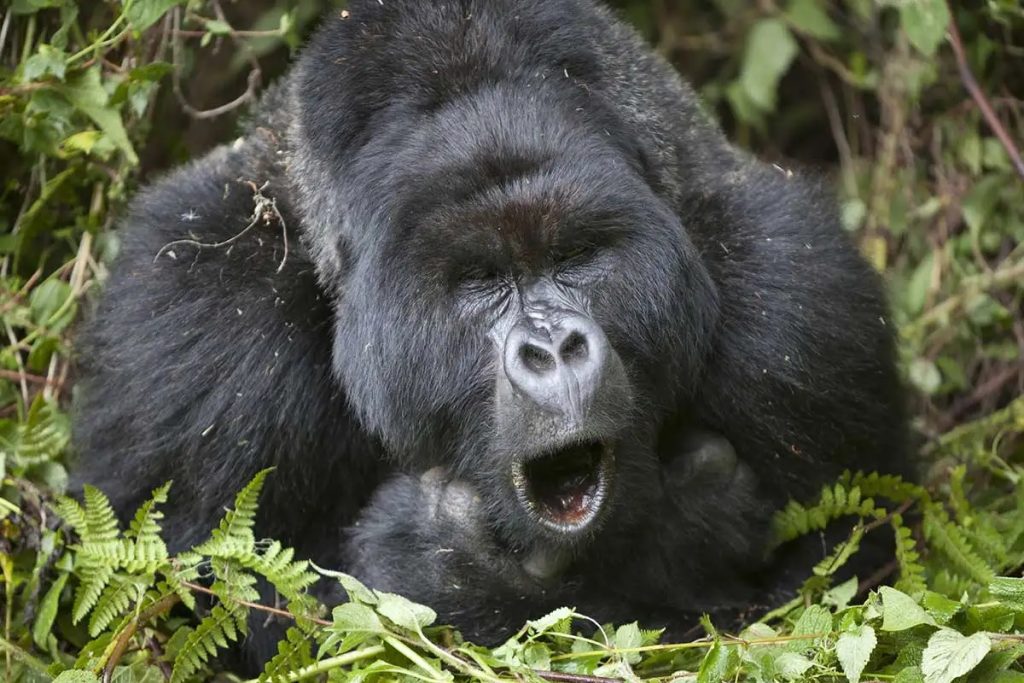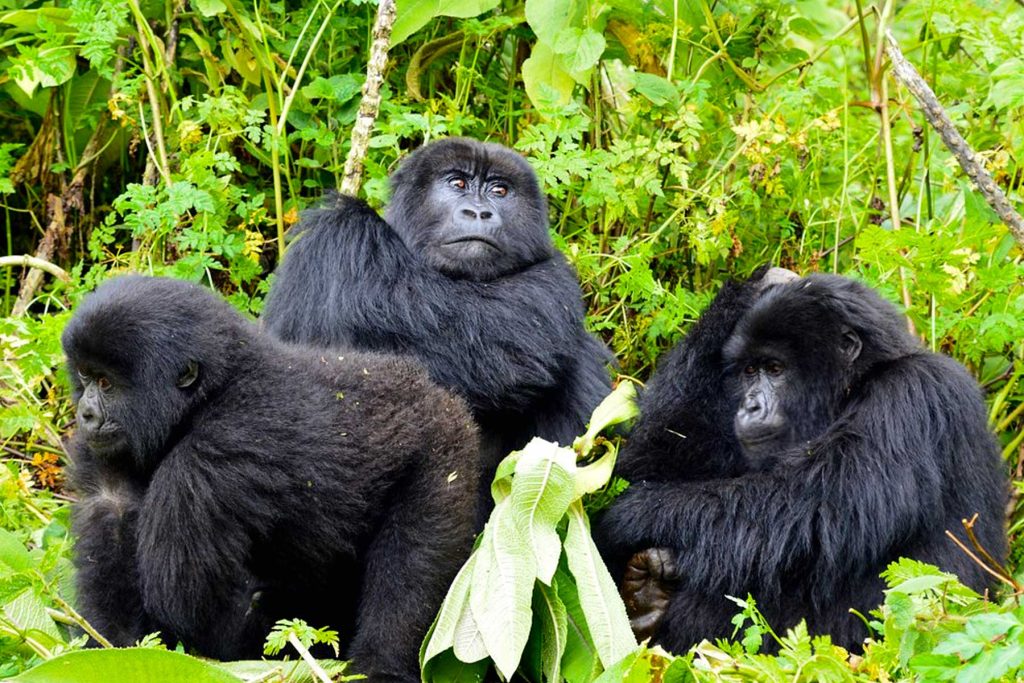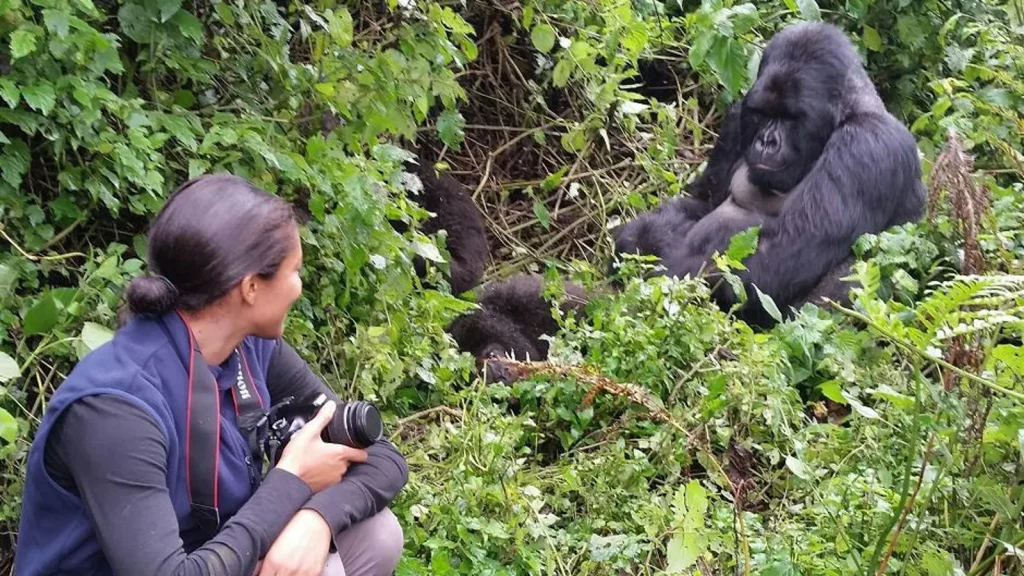Gorilla Trekking in Rwanda
Gorilla Trekking in Rwanda
Rwanda gorilla trekking is an adventure that takes you to the jungles of volcanoes as you feel the mist settling on your sleeves. The forest is alive around you—cool, quiet, and smelling faintly like eucalyptus tea.
There’s no real walkways, just a narrow space where your guide gently slices through the bamboo with his machete. Every step sinks into soft, damp earth that smells like moss and new beginnings. You can see your breath in the cold mountain air.
Then—something. A low grunt, calm and deep, rolls through the bushes. You stop. A young tree wobbles. The leaves shake. And then he’s there. A silverback gorilla, massive and calm, with dew on his black fur and eyes that seem to hold time still. He looks at you—not with fear, not with aggression—but like he invited you over and is quietly amused that you showed up.
For one quiet hour in the presence of these gentle giants, nothing else matters. No phone. No clock. Just your breath, your heartbeat, and this moment you’ll never forget.
Why Go Gorilla Trekking?
Seeing a gorilla in the wild isn’t just exciting—it’s humbling and truly unforgettable. An encounter with the wild giants in their natural habitat, an encounter with an intelligent being that size you up in seconds.
A single glance from a 200-kilo silverback can definitely shake up everything you thought you knew about power.
And your visit does more than give you a story to tell because for every entrance, there is a job offered to a local community.
Every permit helps protect these gorillas, pays rangers, supports local schools, and funds emergency care for the animals. You’re part of something bigger—a conservation story that needs people to show up and care. Just like you’re doing.
Where Can You go for Gorilla trekking?
Volcanoes National Park, Rwanda
If you want something smooth and easy, this is the place. Just 2.5 hours from Kigali Airport and you’re sipping coffee by the fire in a beautiful lodge. The treks are well-organized, the guides are incredible, and everything runs like clockwork. It’s not cheap, though—permits are $1,500 and they sell out fast.
Bwindi Impenetrable Forest, Uganda
Bwindi is wilder, wetter older and gorilla trekking here feels like stepping into a different world—dense jungle, steep paths, and a real sense of adventure. Permits here are $800, and you’ll find everything from backpacker-friendly stays to luxury hideaways. It’s more effort, but it feels incredibly real—like you’re part of the forest, not just passing through.
Virunga National Park, DRC
This one’s for the bold and those guests who are risk takers because Virunga is less safe for most guests. Permits are around $400, and you can even hike an active volcano at night. But this isn’t a soft, curated experience—you need a good guide, flexible plans, and a taste for adventure. It’s raw, rugged, and unforgettable (as long as you don’t mind a few rough edges).
When’s the Best Time to Go?
Dry seasons—June to August and December to February—are ideal. During these months the trails are firmer, the gorillas are easier to find, and the weather’s great for photos. But it’s also peak season, so permits go fast.
If you don’t mind some rain, go during the shoulder months—March to May or September to November. Everything’s greener, prices are better, and you’ll have fewer crowds. Sure, it’s muddy. You’ll get dirty. But it adds to the story—and might even help you afford a beach escape in Zanzibar afterward.
How to Plan It
Get your permit first. Don’t even book flights until that’s done. Permits are limited and they’re the key to everything. Once you have it, pick your park, choose a good tour operator, and sort out your flights. Kigali is your entry point for Volcanoes and Virunga. Entebbe is the way in for Bwindi.
Add a buffer day before your trek. The briefings start at 7:00 a.m., and they won’t wait for a delayed flight. After your trek, give yourself a soft landing—maybe a sunset paddle on Lake Kivu, a coffee farm tour, or a relaxed game drive. Let your body and mind catch up before heading back to regular life.
Helpful Tips
- Hire a porter. It’s affordable (about $15), they’ll carry your stuff, help you on slippery trails, and you’ll be supporting a local family.
- Do a little training. Walking up hills at high altitude is no joke. A few weeks of stair climbs will make your trek so much easier.
- Dress in layers. Mornings are cold, the hike warms you up fast, and then the mist cools everything again. Quick-dry clothes and a rain jacket are your best friends.
- Bring gloves. Nettles are sneaky, and a cheap pair of gardening gloves will save your hands.
- Stay quiet. Gorillas pick up on tone, not words. A whisper makes the whole moment feel more sacred.
- Carry small bills. Trackers and porters rely on tips, and you won’t find an ATM on the trail.
Gorilla Trekking in Rwanda Gallery
Suggested Tours
FAQs
Will I actually see gorillas?
Yes—most of the time. Success rates are above 95%. Guides go out early, find fresh nests, and direct your group to where the gorillas are. On rare days, terrain might make a group unreachable, but they’ll either find you another one or rebook you for the next day. Always leave one buffer day just in case.
Is the hike really hard?
It depends on your fitness. Some treks are short and easy, others can take a few hours with tough uphill climbs. If you can walk up five city blocks without stopping, you’re probably fine. Porters carry your stuff and guides adjust the pace for the group.
Is Gorilla trekking in Rwanda safe?
Yes. These gorilla families are used to seeing humans. Rangers know exactly what to do and will guide you if anything changes in the gorillas’ behavior. Real incidents are very rare. Rwanda and Uganda are stable and safe for visitors. Virunga just requires more planning and caution.
What gear should I bring?
Good hiking boots, comfortable socks, waterproof pants, long sleeves, a breathable rain jacket, gloves, gaiters, water, snacks, and a camera with no flash. If you have a 70–200mm zoom lens, it’s perfect for gorilla portraits without carrying too much weight.
Can I go alone?
Sure. You’ll be grouped with up to 7 other people, and most solo travelers make friends quickly. If you prefer to trek alone, some lodges offer private options for an extra fee.
Is Gorilla trekking ethical?
Yes—if you follow the rules. One hour max with the gorillas, small groups, mask required, keep your distance. Part of your permit fee goes to local communities. And the best part? Gorilla populations are growing, thanks to responsible tourism. It works—your visit helps.
Can I add other adventures to my trip?
Definitely. Many people pair gorilla trekking with a Serengeti or Masai Mara safari—just a short flight away. Or hop down to Zanzibar for some beach time. Closer options include coffee tours at Lake Kivu or paddling in Uganda’s Lake Bunyonyi—perfect ways to unwind and reflect.
So, are you ready?
To trade your screen for the steady eyes of a wild gorilla? To feel your pulse echo in a place where time moves differently? Rwanda’s forests are waiting—and the gorillas already know the way.










